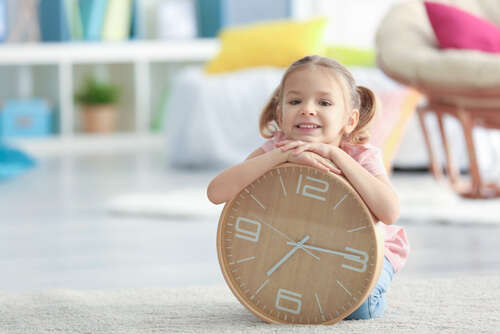Help Your Child Learn the Concept of Time
Jan 15, 2022 Motivating kids to complete tasks in a timely manner can be a daily struggle. I know it is at my house. Especially now, I find myself even struggling with time management skills, so I cannot imagine how young kids are feeling!
With the recent current events and everything changing in our lives, I am motivated to change that and I figured there may be more parents like me that feel the same way. Mindy Hudon, the creator of Bee a Time Keeper clock, shared a few strategies on how to help our children grasp the concept of time and how to manage it better, which I’ll be breaking down and explaining to you. Be sure and check out her clock. It is a wonderful product for teaching young kids the concept of time.
First of all, time is a very abstract concept for children to try and comprehend. The ability to manage our time is an example of an executive functioning skill. Executive functioning refers to the brain functions that make it possible for us to manage life tasks such as planning our day, controlling impulses, and determining how much time we have to complete a task.

Even though children are not typically taught the basics of reading clocks until second grade, we still expect them to understand how time moves. “You have 5 minutes until bedtime,” “we need to leave in 10 minutes,” are all examples of how we expect youngsters to understand movement of time.
So what’s wrong with that? I do that every single day in my household. One reason youngsters struggle with complying with adults requests around time is because they have not yet developed the ability to “feel” the passage of time and self-manage accordingly. This can be frustrating for both adults and children. If children can be led to experience what time feels like, then they can become better self-managers.
Strategies To Use at Home
Odds are, most of you have tried at least one of these examples to try and teach the concept of time. If not, I’m hoping it provides you with several other options you can try.
Boost Your Child’s Speech Development!
Improve language & communication skills with fun learning!

Countdown Timers
Who hasn’t used the kitchen “countdown” timer to get their child to complete a task? It’s easy and convenient and in most instances gets kids moving. “I’m setting the timer for 5 minutes.” Although it gives us some parenting control, the anticipation of not knowing when the timer will go off can cause a bit of anxiety for our children. I’ve seen this happen in my students at school. They are constantly looking at the timer waiting for it to hit zero. So if you see this happening in your child, I’d suggest another strategy.
Visual Timers
This type of time management tool is often used in schools to help children see how much time they have left. There are different types of visual timers on the market including sand timers, disappearing colored dials, or three colored light towers. Children are able to “see” their time disappear, but it does not teach children how to plan future time or develop necessary clock skills. This is what I use for my high school students. Believe it or not, some of them cannot read clocks, especially analog clocks. Being able to see the numbers counting down helps them to prioritize and figure out the best way to tackle tasks.

App Timers
Search the App Store and you will find a plethora of time management apps for kids. There are different types of apps for different needs. There are visual timers, countdown timer apps, chore timers, and game related timers that reward children for their efforts. The problem using technology is that it can become a distraction for children, rather than a tool to assist them with time management. Depending on the child, using apps may be adding to the problem rather than helping children be better self-managers. Again, if this sounds like your child, don’t use it!
Bee A Time Keeper
For younger children (ages 3-8), it is more effective to use a child-friendly analog clock. The Bee A Time Keeper clock uses strategic placement of bright colors and child-friendly critters on an analog format to provide a fun, non-threatening way to develop children’s time management, planning, transitional, and self-regulation skills. The Bee A Time Keeper clock is beneficial for both home and school. Using the clock is easy. First, place the clock at eye level. On the hour hand, there is a “SNAIL” and on the minute hand, there is a “BEE”. Discuss the concept of fast/slow and then talk about how minutes move faster than hours and that is why the “BEE” is on the minute hand and the “SNAIL” is on the hour hand. Tell the children they will “Bee A Time Keeper.” By touching the clock and showing them where the “BEE” is, you can plan ahead and help them learn to be better self-managers.
What’s my favorite? As a therapist and a mom, I highly recommend the Bee A Time Keeper for younger children or children who find technology distracting. For kids that can deal with numbers and not be stressed – the visual alarms work great!
